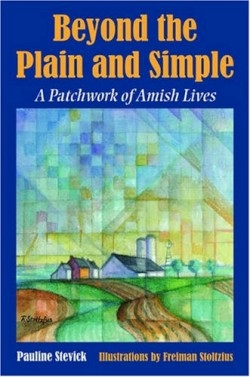It looks like you've stumbled upon a page meant to be read by our code instead of viewed directly. You're probably looking for this page.
Beyond the Plain and Simple
A Patchwork of Amish Lives
Men with beards, dark suits, and wide-brimmed hats; ladies clad in long dresses adorned with aprons, crisp white head coverings in place. These images are what most mainstream Americans think of when they hear the word “Amish.” But behind this quaint picture exist the real lives of men, women, and children: their day-to-day work, their surprisingly complicated social interactions, their nuanced philosophical convictions.
These real lives are what the author, adjunct instructor of English and interdisciplinary studies at Messiah College, seeks to portray. She and her husband have cultivated friendships with many Amish families, attending their church services, weddings, and funerals, sometimes even spending the night at their Amish friends’ houses. In this book, Stevick has compiled a sort of anthology of her experiences with the Amish way of life: she attends a wedding, interviews an Amish intellectual, goes to church, and even vacations at an Amish resort.
Displaying a firm grasp of the theological underpinnings of the Amish churches, Stevick begins with a fascinating, if short, history lesson. In the seventeenth century, she explains, a group of Swiss Anabaptists fled Switzerland for France due to persecution for their belief that Christians should be baptized as professing adults, not as infants. Led by Jacob Amman, the “Amish” ratified the tenets that their descendants still embrace today: the shunning of wayward members, plain dress, and twice-yearly communion, among others.
The book is not an encyclopedia of Amish beliefs, though it does detail several. Nor is it a dictionary of terms related to the Amish, although the reader will find explanations of words and phrases such as Gelassenheit (submission to the will of God and community) and unner Sucht (describing a topic under investigation by church leaders). It is, rather, a pastiche of impressions and interactions with the Amish community, as told by an inquisitive outsider.
The Amish are not the only group descended from Anabaptist wing of Protestantism, and the uninitiated may sometimes confuse them with their theological cousins, Mennonites and Brethren, even today. Indeed, as Stevick explains, Amish itself is not a univocal term: several orders of Amish exist, from liberal to conservative. “Tourists who drive through Holmes County, Ohio, and admire the togetherness of the Amish community,” Stevick notes, “might be surprised to find out that many of the Amish persons who greet each other at the auction or the supermarket cannot take communion with one another.”
It is this fascination with the differences between seemingly identical people—this refusal to stereotype or generalize—that makes Stevick’s stories so compelling. Always detailed, they are, at their very heart, real. Sometimes approving of, and sometimes challenging Amish practices and beliefs, Stevick allows the reader to vicariously interact with this usually arcane way of life.
Reviewed by
Melanie Seibert
Disclosure: This article is not an endorsement, but a review. The publisher of this book provided free copies of the book to have their book reviewed by a professional reviewer. No fee was paid by the publisher for this review. Foreword Reviews only recommends books that we love. Foreword Magazine, Inc. is disclosing this in accordance with the Federal Trade Commission’s 16 CFR, Part 255.
